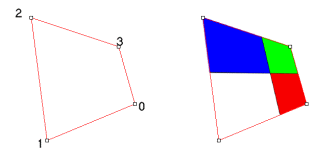| Visual Basic (Declaration) | |
|---|---|
Public Class CombineWarpCommand Inherits RasterCommand Implements IRasterCommand | |
| Visual Basic (Usage) |  Copy Code Copy Code |
|---|---|
| |
| C# | |
|---|---|
public class CombineWarpCommand : RasterCommand, IRasterCommand | |
| C++/CLI | |
|---|---|
public ref class CombineWarpCommand : public RasterCommand, IRasterCommand | |
This example will warp combines two images.
| Visual Basic |  Copy Code Copy Code |
|---|---|
Public Sub CombineWarpCommandExample() | |
| C# |  Copy Code Copy Code |
|---|---|
public void CombineWarpCommandExample() | |
You can warp the entire source image, or a portion of the source image. To warp a portion of the source image, set SourceRectangle accordingly. To warp the entire source image, set the following:
CombineWarp.Command.SourceRectangle = new Rectangle(0, 0, RasterImage.Width, RasterImage.Height);
The warp area in the destination image is specified in SetDestinationPoints. The polygon specified in SetDestinationPoints must:
Be concave Fit entirely on the destination bitmap
If either of these conditions is false, this class will throw an exception.
The ordering of the points in SetDestinationPoints can affect the resulting warp. For example, if the source image is the following:

then ordering the points in SetDestinationPoints as shown below results in the following warp:

while ordering the points in SetDestinationPoints as shown below, results in the following warp:

The CombineWarpCommand works by combining the image in the DestinationImage property with the image passed to the RasterCommand.Run method. The DestinationImage will then hold the result of the combine operation..
For more information, refer to Introduction to Image Processing With LEADTOOLS.
This command does not support signed data images.
System.Object
Leadtools.ImageProcessing.RasterCommand
Leadtools.ImageProcessing.CombineWarpCommand
Target Platforms: Microsoft .NET Framework 3.0, Windows XP, Windows Server 2003 family, Windows Server 2008 family







~198.gif)